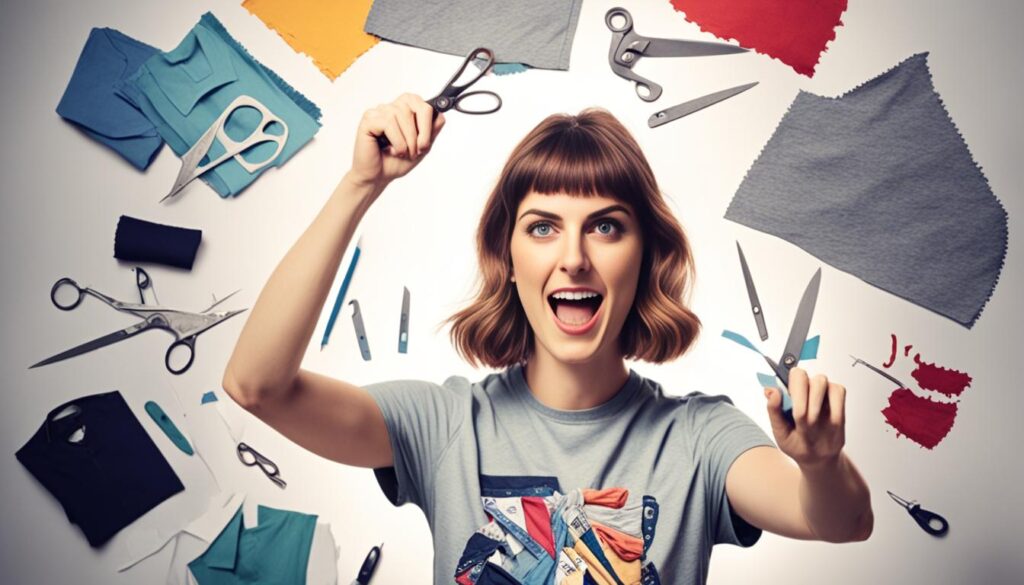Have you ever thought about giving old clothes a new life? Upcycling fashion is a creative and sustainable way to transform these pieces. But what is upcycling fashion and what are its benefits? Let’s take a look!
Key Highlights:
- The practice of upcycling clothes involves transforming old pieces into new, stylish, and unique ones. It is a sustainable alternative.
- Upcycling is economical. You can create new pieces without buying new clothes, saving money.
- This practice promotes the creation of unique pieces. They reflect the creator’s personal style and creativity.
- Popular ideas include turning jeans into shorts or skirts, customizing t-shirts, and reusing fabrics in new creations.
- Clothing upcycling is sustainable. It helps save money, develop skills, and express creativity. This benefits both the environment and fashion.
What is Upcycling Fashion?
Clothing upcycling transforms old pieces into new and unique ones. Unlike recycling, it uses the clothes as a base to create something new, without destroying them completely.
Concept of Clothing Upcycling
The Concept of Upcycling in fashion creates new items from existing materials. This is done with low cost and without excessive energy. Additionally, it does not use harmful chemicals.
This practice extends the lifespan of products. It avoids disposal and replacement with new ones, thus reducing textile waste and the environmental impact of fashion.
Differences Between Upcycling and Recycling
Clothing Recycling transforms old fabrics into new ones. But Upcycling uses less energy and materials. It also reduces emissions and water usage.
Furthermore, Upcycling avoids the release of microplastics into the oceans, making it a more sustainable option for transforming clothes.
Benefits of Clothing Upcycling
Clothing Upcycling reduces textile waste and saves money. It also creates unique pieces that express personal style. This helps promote circular economy.
Nearly 90% of consumers prefer sustainable companies. This shows the importance of sustainability in product choices. Brands like Insecta Shoes and Comas are examples of companies that adopt Upcycling. They attract consumers who value responsible practices.
How to Learn Upcycling Fashion
Those interested in learning clothing upcycling have several options. They can use online resources, courses, or in-person workshops. These options help develop the skill to create sustainably.
Online Resources and Courses
Platforms like blogs, social media, and YouTube offer many creative ideas and tutorials on Learning Upcycling. There are also Online Upcycling Courses taught by designers, allowing for experience exchange with other students.
Workshops and In-Person Classes
For those who prefer hands-on learning, In-Person Upcycling Workshops are ideal. In these workshops, students work with fashion professionals, learning to customize, transform, and repurpose pieces through practical lessons.
“Upcycling is gaining momentum in the sustainable fashion world, offering a significant opportunity to create a circular economy.” – Selina Sanders, fashion designer specializing in upcycling.

With many online and in-person resources available, it’s easy to Learn Upcycling. This allows you to turn old clothes into unique and stylish pieces.
Upcycling Fashion: Ideas and Inspirations
Clothing upcycling is becoming increasingly popular. This is because it involves Clothing Customization, Piece Transformation, and Shirt Reuse. Thus, it transforms old items into new and unique ones.
Customizing T-Shirts
An easy way to Customize Clothes is to personalize t-shirts. You can add lace, patches, or cutouts for a unique touch. This is great for giving simple t-shirts a new life.
Transforming Pants into Shorts
Another idea is to transform jeans into shorts. Just cut the length and add details like frayed hems or pockets. It’s a fun way to use old pants.
Reusing Shirts as Dresses
Reusing Shirts is also a good option. Men’s shirts can be turned into women’s dresses with some adjustments. It’s a charming way to give old shirts a new life.
These are just a few ideas to give your clothes a new life. Upcycling shows that recycling can be very creative.
“Clothing upcycling involves creatively rethinking past pieces that no longer make much sense in the current context, sparking creativity and generating new ideas.”
| Relevant Statistics | Impact |
|---|---|
| In recent years, there has been a significant increase in the popularity of the upcycling process in the fashion world. | Upcycling has become a practice adopted by various brands, which have renewed themselves to repurpose pieces in their collections, creating unique clothing. |
| The impact of fashion productions has become less harmful to the environment due to the repurposing of clothing and accessories through upcycling. | The practice of upcycling involves creatively rethinking past pieces that no longer make much sense in the current context, sparking creativity and generating new ideas. |
Materials and Tools for Beginners
To get started with upcycling, you don’t need many tools and materials. However, some essential items can be very helpful. They make your creations more professional.
Sewing Machine and Accessories
A Sewing Machine is an essential tool for creating new pieces. Accessories like needles, threads, and sewing patterns make the process easier and more efficient.
Fabric Scissors and Cutting Tools
Fabric Scissors are ideal for cutting fabrics. It’s important to have sharp scissors to ensure precise cuts. Other cutting tools can be used for detailed work.
Creative Materials for Customization
Creative Materials like patches, paints, and fabrics can be used to add personal touches. They help transform pieces into unique creations.
Conclusion: Embracing Upcycling in Fashion
Clothing Upcycling is a sustainable and creative practice. It’s an excellent way to transform old pieces into new and stylish ones. By adopting this practice, you contribute to the environment and develop unique pieces that reflect your personal style.
Explore different Upcycling Ideas, use the tips provided, and embrace this practice to create new fashion trends.
